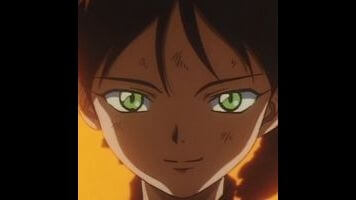The iconic status that “Ballad of Fallen Angels” has earned in Cowboy Bebop’s 26-episode-long run is a no-brainer. Its cynical, grandiose melodrama is worthy of Brian De Palma, particularly the episode’s climactic church shoot-out. That scene is an homage to John Woo’s The Killer but the fantastic, explosive flashback that ends that scene is reminiscent of De Palma’s Obsession. The biggest trauma of Spike’s life resurfaces in that sequence in a hail of bullets and indecipherable archetypal images. The violence in “Ballad of Fallen Angels” is the stuff of film noir and opera, typified by hazy flashbacks fraught with loaded images and high falutin, sometime blasphemous, dialogue like, “Angels that are forced from heaven have to become demons. Isn’t that right, Spike?” Though its sometimes too serious for its own good, “Ballad of Fallen Angels” deserves its prominent place in Cowboy Bebop’s mythology.
“Ballad of Fallen Angels” begins with a negligible encounter between two men that come out of Spike’s past: Vicious, a too-appropriately named villain, and Mao Yenrai, a businessman whose throat is slit a minute or so after we meet him. Right after Vicious kills Mao, we’re thrown mid-scene into a quietly turbulent confrontation between Jet and Spike, the latter of whom is feeling pretty punchy. Spike acts like the noirish loner that Cowboy Bebop’s first session set him up as. He knows better than Jet does about Mao and he petulantly throws that knowledge in his partner’s face. When Jet asks him who Mao is and what he means to Spike, Spike deflects the question by replying, “So…what happened to that arm of yours?” Spike’s past is threatening to overtake his carefree present and that knowledge is destroying him.
Spike’s destiny is ruled by his past. He goes out of his way later in “Ballad of Fallen Angels” to re-assure Faye that, “I’m not going there to save you,” making it impossible for the viewer to blame anyone but Spike for his decision. His past is the foundation that his improvisatory current lifestyle is built on. The problem is we don’t know exactly what that entails just yet. Though “Ballad of Fallen Angels” is a mythology episode for the show, it barely gives us any details about Spike’s past after a point. We know that he and Vicious once worked together and that Vicious is related to the opening memory montage we saw at the beginning of the show’s first session.
But the most important thing we learn from “The Ballad of Fallen Angels” about Spike’s past is that the very mention of his past raises his hackles. He only goes into noir mode as a defense mechanism. I especially like when he asks Jet where Faye went as if he were Sam Spade: “Where’s the broad?” Initially, Spike treats his self-appointed mission to avenge Mao, who we learn was a mentor of Spike’s, as a personal debt he feels he must honor. When Jet asks him point-blank why he is compelled to do right by Mao, Spike cagily responds, “Let’s just say the duties of the life I live.” Getting back at Vicious is the price he has to pay for his new nomadic life.
It’s incredible to think that the stakes of Spike’s quarrel with Vicious are set up as quickly as they are in “Ballad of Fallen Angels.” But the combination of blustery symbols and over-the-top scenes of violence that are used to make Vicious look like a serious threat are undeniably effective. The ominous scene at the opera house, when Faye discovers Mao’s body, is expertly paced, especially the moment where we first hear Vicious’s name. Faye has just learned that Mao is dead and his body was used as a prop to lure her into close proximity with Vicious. “Who…are you,” she fearfully asks Vicious. Then a pause as the aria being performed reaches a crescendo. And Vicious says his name. Then we get a brief close-up of Faye’s alarmed face that feels like it lasts for much longer than it does. “Ballad of Fallen Angels” is similarly bombastic but economic throughout its 22-minute runtime. It just might be the most tightly scripted and directed episode of the series.
And it all pays off during the episode’s big church shoot-out. To be perfectly honest, I still don’t find Spike and Vicious’s cryptic exchanges to be nearly as engaging as the cartoony, The Killer-style gunplay in this scene. Faye breaks up some of Spike and Vicious’s heavy-handed dialogue with some much-needed comic relief, like when she yelps, “Are ya tryin’ to kill me,” after stray bullets narrowly miss her pendulous breasts (She’s apparently not wearing a bra, boys! Woohoo!).
What’s most impressive to me about “Ballad of Fallen Angels” is that one De Palma-esque scene where Spike falls to what should be a certain death. His life with Vicious flashes before his eyes, like the glimpses of Spike’s past we get at the beginning of Cowboy Bebop’s first session. In fact, that footage is combined with new scenes of Spike and Vicious teaming up and of a mysterious figure tearing paper up and throw it out of a window like confetti.
The fact that we don’t know what we’re looking at here is the biggest tease in the episode. But it’s also a dynamic promise of things to come on the show. The last scene in “Ballad of Fallen Angels” is a pat reassurance to the audience that the status quo can be restored even after such a traumatic event. I love the way that Spike’s flashback throws us headfirst into the throes of that major event but doesn’t give us the context to completely understand what’s going on. The show’s main conflict takes center stage here in “Ballad of Fallen Angels” but we’re still a ways away from knowing what comes next for Spike. All in good time, space cowboys, all in good time.









































